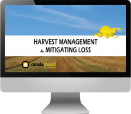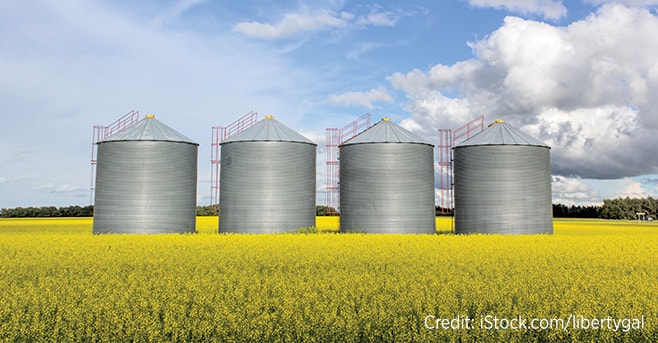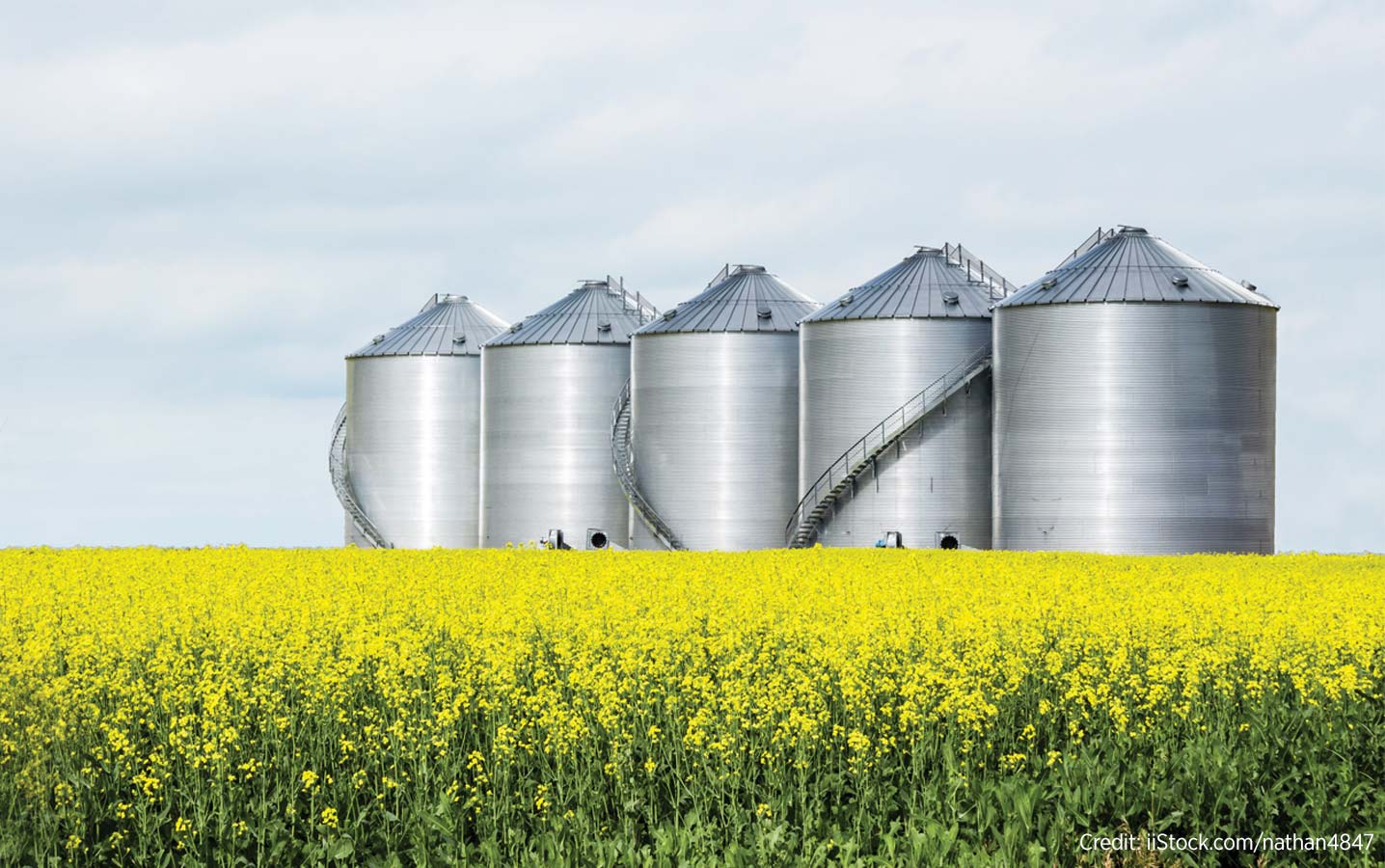Agronomy Insights
New tool helps with combine settings

The new Combine Optimization Tool at canolacalculator.ca walks users through a series of questions to help them identify the issues with grain loss, grain sample quality or productivity. For example, if there are too many “free grain” losses coming out the back of the combine, which would be determined with a drop pan, the tool provides a number of setting adjustments to try. Adjustments should be done one at a time, with drop pan samples taken after each adjustment.
Adjustments to increase cleaning capacity:
- Open upper sieve in 3 mm increments.
- Open pre sieve in 3 mm increments (if available).
- Open rear section of upper sieve in 3 mm increments (if available).
- Loss may be due to “sluffing” or “blowing.” Try increasing and/or decreasing fan speed by 100 rpm.
- Open lower sieve as much as possible while maintaining an acceptable
grain sample
Try the tool yourself at canolacalculator.ca. For more on how to use a drop pan and how to calculate losses, read, “How to reduce costly harvest losses” at canolawatch.org
Video on how to measure harvest loss
 Watch the Canola Council of Canada (CCC) video, “Harvest management and mitigating loss” for tips on how to take a sample and measure the loss. Find the video at the CCC channel at youtube.com/canolacouncil.
Watch the Canola Council of Canada (CCC) video, “Harvest management and mitigating loss” for tips on how to take a sample and measure the loss. Find the video at the CCC channel at youtube.com/canolacouncil.
What increases canola storage risk?
Moisture. Canola at eight per cent moisture is considered safe for long-term storage. High-moisture canola stored cool or cold may last longer without spoilage, but this bin will become very unstable with any stretch of warm weather. It helps to have a drying, storage or marketing plan before taking high-moisture canola off the field.
Hot grain. Canola binned hot, even if it has low moisture, low dockage and low green, should still be put on aeration. This will even out the temperature throughout the bin and help remove moisture from respiring seed. Warm seed and any moisture create a favourable environment for the microbes that lead to heating. Canola should be cooled to 15°C or less as soon as possible.
Green seed. Green canola seeds can increase the storage risk, even if canola is dry and cool. Monitor closely. Small, shriveled canola seed, which often occurs in combination with high-green seed, can mean smaller air pockets between seeds in the bin. This can increase the resistance to air flow.
Dockage. Weed seeds and green weed material tend to contain more moisture than canola seeds. This high-moisture dockage may not be enough to elevate overall grain moisture tests, but if it concentrates in pockets in the bin, it can create localized hot spot for spoilage to begin. Chaff tends to concentrate closer to the walls of the bin and fines closer to the centre of the bin. This distribution exaggerates airflow problems because air tends to take the path of least resistance.
Bin size. The bigger issue with large bins is airflow due to increased grain depth. Can the aeration system get air to all areas and can it push through to the top? Being a small seed, canola has a higher resistance to airflow than most other crops stored on the Prairies. With more depth, the compaction and resistance to airflow increases. The other risk with large bins of the canola is the high value within a single bin if something does go wrong.
Fan size. A bin of canola generates a high static pressure (or resistance to airflow) which results in a lower airflow rate from the fan. For conditioning (cooling), you need 0.1 to 0.2 cfm/bu. of airflow. If adding supplemental heat to dry canola, airflow of at least 0.75 cubic feet per minute per bushel is recommended. If fan size is insufficient for the job, fill the bins part way to improve airflow.
Bags. Grain storage bags don’t have airflow and grain temperatures inside bags fluctuates more with changes in outside temperature, and they are often not as accessible in winter if something goes wrong. Bags are still generally considered a short-term storage solution for canola.

No malathion in canola bins
Canada exports 90 per cent of the canola we produce, and shipments containing even the smallest amount of unacceptable residues or de-registered varieties can be rejected, causing millions of dollars in losses and placing future business at risk. One risk is malathion.
Never use malathion to prepare canola for storage or to treat bins used to store canola. Its residue can linger for up to six months, so choose your canola storage bin carefully.
Other storage requirements to “Keep It Clean” are:
- Make sure your storage bins are free of treated seed and animal protein like blood meal and bone meal.
- Clean bins thoroughly prior to storing your crop.
 Only use approved bin treatments (e.g. diatomaceous earth on cereals).
Only use approved bin treatments (e.g. diatomaceous earth on cereals).- Condition crops to moisture and temperature levels safe for long-term storage.
- Keep bins cool, dry, well-ventilated and check their condition regularly.
Find more tips at keepingitclean.ca.
Moving soil, moving clubroot
With dry conditions last fall in combination with an apparent uptick in tillage, CCC agronomy specialists noticed more dust in the air than we’ve become accustomed to over the past few decades. This means a direct loss of precious topsoil. It also means a biosecurity risk.
Tillage moves a lot of soil, either on the equipment itself or with the increase in wind and water erosion that results. Moving soil means moving clubroot. Moving soil also means moving verticillium, aphanomyces (pea and lentil disease), phytophthera (soybean disease), weed seeds and nematodes.
Canola Discovery Forum October 22-23
Canola Discovery Forum 2018 in Banff, Alta., kicks off Monday afternoon, October 22, with a two-hour discussion on CCC agronomy messaging for 2018-19. After that is a panel on, “How can we manage prospective loss of key agronomy tools?” Tuesday is a full day digging into canola stand establishment, with discussions on recommendations for plant populations, new seeding technology, seed-placed fertilizer, insect management, herbicide-resistant weeds and more. Register online at canolacouncil.org. Go to the Events page under the “What We Do” banner.
Canola Watch has your back
 The CCC agronomy team has weekly conference calls through the growing season to discuss insect, disease and other canola crop management issues that pop up. The team then works with research and extension specialists to convert that discussion into timely tips shared through the weekly Canola Watch email. Canola Watch provides useful agronomy back up for farmers, agronomists and retail staff. Sign up for the emails at canolawatch.org. You can also follow @canolawatch on Twitter.
The CCC agronomy team has weekly conference calls through the growing season to discuss insect, disease and other canola crop management issues that pop up. The team then works with research and extension specialists to convert that discussion into timely tips shared through the weekly Canola Watch email. Canola Watch provides useful agronomy back up for farmers, agronomists and retail staff. Sign up for the emails at canolawatch.org. You can also follow @canolawatch on Twitter.
Get to Know Your ccc agronomy team
Find the whole team at canolawatch.org/contact-us.
 Angela Brackenreed
Angela Brackenreed
Agronomy Specialist, Eastern Manitoba
Contact: 204-720-6923 and
brackenreeda@canolacouncil.org
Twitter: @BrackenreedCCC
Specialty: Harvest and storage
 Ian Epp
Ian Epp
Agronomy specialist, Northwest Saskatchewan
Contact: 306-371-7913 and
eppi@canolacouncil.org
Twitter: @EppCCC
Specialty: Weeds
 Keith Gabert
Keith Gabert
Agronomy Specialist, Central Alberta South
Contact: 587-377-0557 and
gabertk@canolacouncil.org
Twitter: @GabertCCC
Specialty: Insect pests, liming





